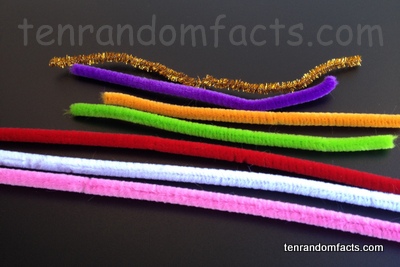Pipe cleaners were once a cleaner and now a craft.
- A pipe cleaner is a long, narrow cleaning utensil that has an abundance of absorbent fibres attached.
- Pipe cleaners are also know as ‘chenille stems’ and ‘chenille sticks’.
- Pipe cleaners are most commonly used for cleaning narrow, hollow objects or used in craft projects, and they come in a variety of shapes and thicknesses, with the typical shape being cylindrical.
- Pipe cleaners are commonly coloured in various bright colours and they can be bicoloured or metallic, while the colours are sometimes used to categorise different things or used for craft purposes.
- Pipe cleaners are generally made of a few pieces of wire that secure numerous short strands of cotton, viscose, nylon, polyester or polypropylene, that form short bristles.
- Pipe cleaners were originally invented to clean tobacco pipes, but they can be adapted and used to clean many other items.
- Many different pipe cleaners were invented in the 1800s, although most of them do not resemble modern style ones, although a pipe-stem cleaner, as it was called, with similar qualities, was patented in 1896 by Fredrick Frick, from Rochester, New York, in the United States.
- Pipe cleaners typically range from 15 to 50 centimetres (6 to 20 inches) in length, depending on their purpose, with shorter lengths often used for cleaning, and longer lengths generally used for craft purposes.
- The invention of the modern, chenille style pipe cleaner, is often credited to Charles Angel and inventor John Stedman, who was also from Rochester, New York, in the United States, in the early 1900s.
- The BJ Long company was possibly the first to mass-produce modern style pipe cleaners, since the company was sold rights to Angel’s and Stedman’s design.
Bibliography:
Foster G, John Harry Stedman: His Busy Life and Weird Inventions, n.d, University of Rochester, http://www.lib.rochester.edu/IN/RBSCP/Epitaph/ATTACHMENTS/31_3.pdf
Frick, F 1896, ‘Pipe-stem Cleaner’, US566570, 25 August, p. 1, Google Patents, Google
I Raise my Pipe to the Humble Pipe Cleaner, 2013, rebornpipes, http://rebornpipes.com/tag/history-of-pipe-cleaners/
Pipe Cleaner, 2014, Wikipedia, http://en.wikipedia.org/wiki/Pipe_cleaner






